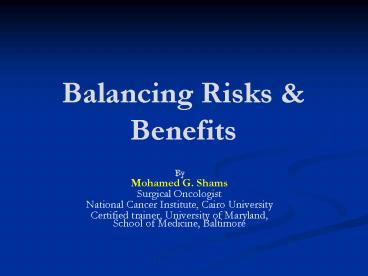Balancing Risks - PowerPoint PPT Presentation
1 / 19
Title:
Balancing Risks
Description:
Medical progress is based on research. This research ultimately rests in part on experimentation involving human subjects ... 3. Venepuncture? Benefits ... – PowerPoint PPT presentation
Number of Views:95
Avg rating:3.0/5.0
Title: Balancing Risks
1
Balancing Risks Benefits
- By
- Mohamed G. Shams
- Surgical Oncologist
- National Cancer Institute, Cairo University
- Certified trainer, University of Maryland, School
of Medicine, Baltimore
2
- Medical progress is based on research.
- This research ultimately rests in part on
experimentation involving human subjects - This involves subjects exposure to risks and
burdens (potential harm).
3
- There should be a BALANCE between the research
aim to scientific progression and development of
generalizable knowledge and the ethical
obligation to protect the welfare and rights of
human research subjects.
4
- CIOMS (Council for International Organizations of
Medical Science ) - For all biomedical research involving human
subjects, the investigator must ensure that
potential benefits and risks are reasonably
balanced and risks are minimized.
5
- WMA declaration of Helsinki
- In medical research on human subject,
considerations related to the well-being of human
subject should take precedence over interests of
science and society.
6
- The Belmont report
- The three basic ethical principles
- Respect for persons.
- Beneficence/ Non-maleficence.
- Justice.
- The three applications
- Informed consent.
- Assessment of Risk and Benefits
- Selection of subjects
7
- What level of harm (risk) should a subject be
allowed to withstand in the name of research?
8
- Risk
- is a function of both the probability and
magnitude of the harm. - For example
- 2 probability of causing death maybe
considered very risky, - while 60 probability of causing dizziness
or headache may be not very risky.
9
Types of risks?
- Physical
- Psychological (anxiety, shame)
- Social (stigmatization, confidentiality
breaching) - Economic (directly or indirectly)
- Legal
- Risks to groups of persons
10
Levels of risk?
- Minimal risk
- More than minimal risk
- High risk
11
Minimal risk
- The probability and magnitude of harm or
discomfort anticipated in the research are not
greater in and of themselves than those
ordinarily encountered in daily life or during
performance of routine physical or psychological
examinations or tests. CFR 45 part46.102(i)
12
Minimal risk
- Examples
- 1. Surveys?
- 2. Observational studies?
- 3. Venepuncture?
13
Benefits
- Benefits conceptually are a function of
opportunity rather than probability. - Ex A study with a small probability of a great
benefit ( cure from a fatal illness) is
considered more beneficial than another one with
a high probability of a minimal benefit.
14
Benefits
- Are either
- Benefits to research subjects.
- Benefits to society.
- N.B. Payment or incentives should NOT be assessed
as potential direct benefit to the subject.
(Offering big sum of money to a high risk study?)
15
Benefits to research subjects
- Direct Treatment, increased knowledge assisting
in diagnosis. - Indirect ( Collateral) extra supervision, access
to medical care, unplanned or unanticipated
benefits.
16
Risk Benefit assessment
- Two main rules (CIOMS)
- 1. Reasonable balance between risks and benefits.
- 2. Risks are minimized ( Using sound research
design scientific validity, inclusion and
exclusion criteria, sample size, qualified
personnel, safety monitoring,,).
17
Risk Benefit assessment
- Risks of interventions of direct diagnostic,
therapeutic or preventive benefit for the
individual subject is justified in relation to
expected benefits to the individual subject. - Risks of interventions of no direct diagnostic,
therapeutic or preventive benefit for the
individual is justified in relation to the
expected benefits to society (generalizable
knowledge).
18
In vulnerable populations
- Ex. In Children, mentally ill, terminally ill,
prisoners or economically deprived populations, - Only a minor increase over minimal risk or
minimal risk studies are justifiable in
non-therapeutic procedures (with no direct
potential benefit to subjects). - In therapeutic procedures, risks should be
reasonably balanced to benefits.
19
- Thank You

